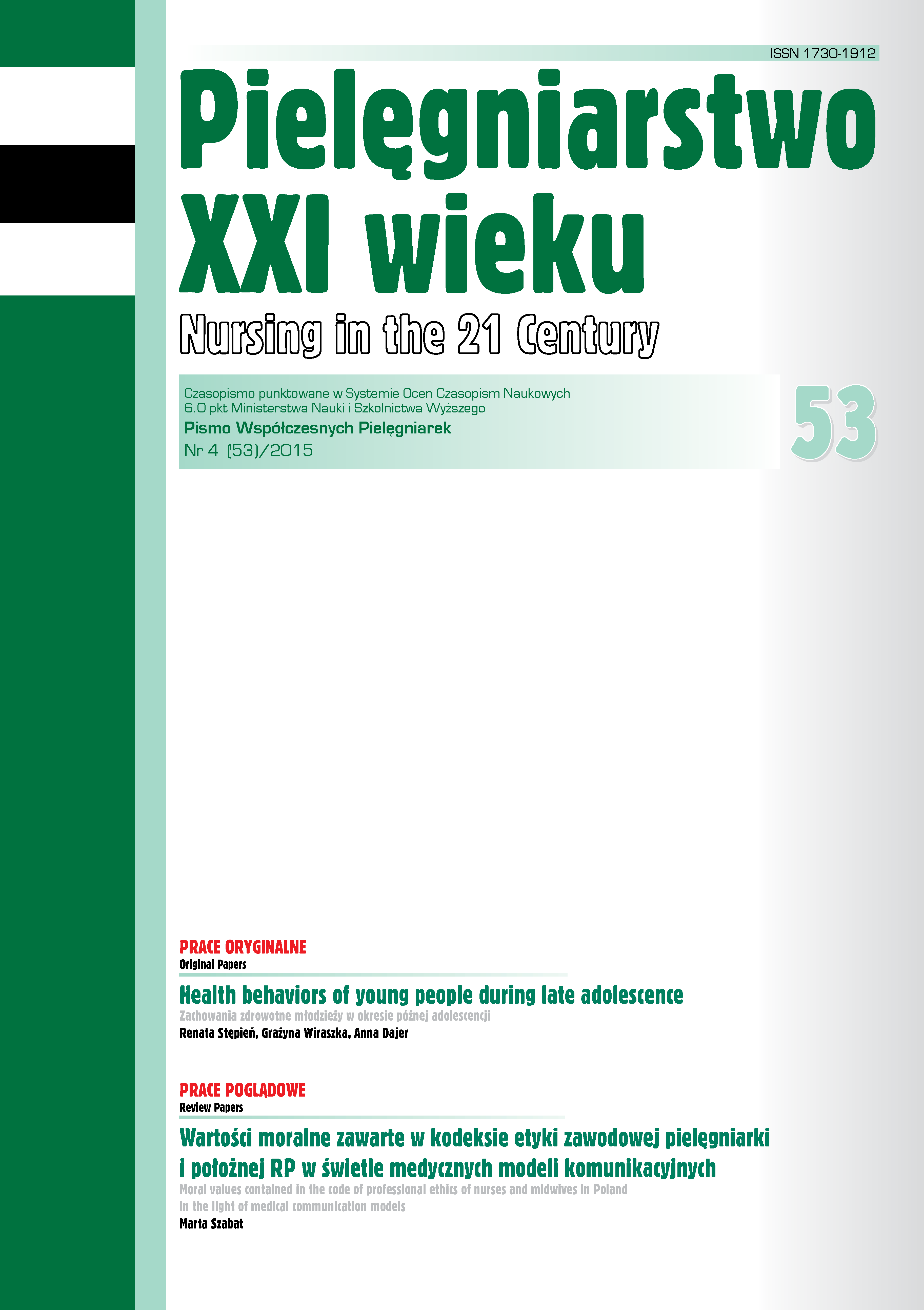Empathy and assertiveness of nurses providing care to patients with psychological and somatic disorders
DOI:
https://doi.org/10.12923/p21w-2015-4/44Keywords:
interpersonal skills, nursing care, empathy, assertivenessAbstract
EMPATHY AND ASSERTIVENESS OF NURSES PROVIDING CARE TO PATIENTS WITH PSYCHOLOGICAL AND SOMATIC DISORDERS
Introduction. It seems that providing care to mentally ill patients requires more developed interpersonal skills than helping patients without mental disorders. Therefore, one might expect that psychiatric nurses would be more empathic and assertive than their colleagues from other wards.
Aim. The aim of the study was to assess empathy and assertiveness levels of nurses working with patients with mental and without mental disorders.
Material and methods. The study covered 120 nurses including 60 psychiatric nurses and 60 nurses from other wars. Empathy levels were measured using Davis’ IRI test, whereas assertiveness was determined using the Assertiveness Map developed by M. Król-Fijewska.
Results. No differences were found between empathy and assertiveness levels of nurses working on psychiatric and non-psychiatric wards. A positive and statistically significant correlation (p=0.01) was discovered between the nurses’ age and their ability to adopt the other person’s point of view.
Conclusion. Nurses’ empathy and assertiveness is unrelated to the type of ward they work on. Cognitive empathy of nurses increases with age – especially their ability to look at things the way patients do. Quality of nursing care could be improved by teaching nurses about communicating with patients. Such training sessions could be especially aimed at inexperienced nurses.
References
1. Poznańska S. Pielęgniarstwo wczoraj i dziś. W-wa: Wyd. PZWL; 1988.
2. Poznańska S. Pielęgniarstwo. [w:] Ślusarska B., Zarzycka D, Zahradniczek K, red. Podstawy pielęgniarstwa. T.1. Lublin: Wyd. Czelej; 2004. s. 21-69.
3. Davis MH. O umiejętności współodczuwania. Gdańsk: GWP; 2001.
4. Król – Fijewska M. Trening asertywności. W-wa: Wyd. Instytut Psychologii Zdrowia i Trzeźwości; 1993.
5. Mojs E. Wybrane aspekty komunikacji pielęgniarka – zespół terapeutyczny. Pielęgniarstwo Polskie. 2006; 2: 135-138.
6. Bączek G, Sobolewska M, Dmoch-Gajzlerska E. Rola komunikacji w przygotowaniu pacjentki do zabiegu ginekologicznego. Problemy Pielęgniarstwa. 2009; 2: 139-143.
7. Kourkouta L, Barsamidis K, Lavdaniti M. Communication skills during the clinical examination of the patients. Progress in Health Sciences. 2013; 1: 119-122.
8. Mandecki M. Znaczenie właściwej komunikacji między personelem medycznym, a pacjentem w opiece zdrowotnej. Pielęgniarstwo XXI wieku. 2005; 4: 93-96.
9. Sanderson CA. Health psychology. NY: Wyd. Wiley & Son; 2004.
10. Mayerscough PR, Ford M, red. Jak rozmawiać z pacjentem. Gdańsk: Wyd. GWP; 2001.
11. Gordon T, Edwards S, red. Pacjent jako partner. W-wa: Wyd. PAX; 1999.
12. Wilczek-Rużyczka E. Empatia i jej rozwój u osób pomagających. Kraków: Wyd. UJ; 2002.
13. Matysiak U. Poziom empatii pielęgniarek jako wyraz profesjonalnej edukacji. Praca magisterska niepubl. Kraków; 2015.
14. Lewicka A. Rozwijanie empatii u studentów pedagogiki specjalnej. Lublin: Wyd. UMCS; 2006.
Downloads
Published
Issue
Section
License
Copyright (c) 2015 Helena Motyka, Katarzyna Motyka (Autor)

This work is licensed under a Creative Commons Attribution 4.0 International License.




